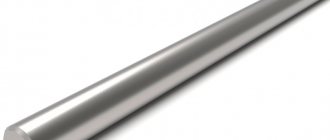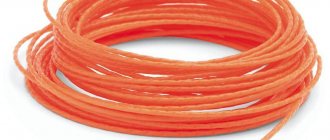Providing individual housing with water from well sources is one of the most common options in houses without access to the central water supply. When drilling, a casing pipe is taken to construct a borehole shaft, the choice of which largely determines the operational life of the source.
The trading network offers a wide range of casing pipes made of different materials with different dimensional and technical parameters. This makes it difficult to make the right decision on the optimal choice of pipes without studying information about their types and parameters.
Rice. 1 Schemes of casing columns, below is a description of the figure:
- One metal casing
- Two-pipe design with an external metal column and an internal plastic service column.
- A plastic pipe is planted to the bottom (bottom) of the well, having previously perforated it to the size of the aquifer.
- The design of a well with an intermediate casing - conductor.
- Transition to a pipe of smaller diameter with a single-pipe design.
- Double-pipe casing design.
- Transition of the production string to a smaller diameter inside the working string.
- The high casing pipe is in loose soil, and the operational plastic pipe is not protected by anything at the remaining distance.
- Single-pipe plastic column design.
Casing pipe: properties and purpose
A water well for a private house is a small-diameter vertical channel drilled in the ground using a special installation. Its depth often reaches several tens or even hundreds of meters. To prevent the destructive effects of natural factors on its walls and preserve the original quality of water extracted from deep layers, a special casing pipe is used for the well.
From the technical side, it performs the following number of functions:
- Prevents wall collapse and ensures the safety of water intake parameters throughout the entire period of operation.
- Eliminates the penetration of ground and surface flows into the watercourse due to the complete sealing of the tunnel.
- Prevents contamination and destruction of equipment from silt, soil particles, suspended particles, and aggressive substances.
- Maintains the original diameter of the well and protects it from ground displacements.
- Provides resistance to the pressure of soil masses.
Diagram of a well with casing Source housecomputer.ru
If drilling is carried out in hard rock or to a shallow depth with a guarantee of maintaining the original parameters of the channel, then a well without casing is allowed. However, most often a pipe string is still installed. Moreover, it can be either single or double.
In the first case, the casing simultaneously plays the role of both a protective contour and a working artery - through which water is directly drawn. The second option is when a separate pipe is installed inside the protective circuit. As a rule, such a need arises when quicksand is detected at the drilling site or there is a high probability of upper runoff entering the well, as well as wall collapse.
Fastening wells during drilling
- Well performance;
- Well lifespan;
- The strength and tightness of the channel through which the extracted product will flow from the horizon to the surface;
- Protection of the operating channel from corrosion;
- The strength of the well walls in places where the rocks are not stable enough;
- Tightness of separation of all permeable horizons from each other.
Securing oil wells involves the use of special columns or packers. The use of columns is the most popular method, which allows you to make the well strong, durable, and also isolate permeable horizons. Such columns are made up of special pipes called casing.
Selection rules
There are two types of criteria, consideration of which allows you to accurately decide which pipe is best to use for a water well, these are:
- Technical.
- Operational.
Factors of the first category include:
- Diameter.
- Method of connecting pipe sections.
- Type of material.
Choosing the diameter of the casing pipe Source ytimg.com
The diameter of the casing pipe for a well is calculated using a special formula, taking into account a number of parameters. It is generally accepted that along the internal contour its value should be at least 110 mm. This is due to two reasons - optimal water intake conditions and the selection of submersible pumping equipment of suitable dimensions.
The well will have better performance characteristics when the pipe segments are fastened with a threaded connection. It will ensure maximum tightness, strength and durability of the casing. In most cases, the installation company decides what diameter the installed pipe string should be and what type of connection is required for it in a particular case.
Factors of the operational category of criteria for choosing a pipe for casing:
- Inertness of the material relative to aggressive environments.
- Resistance to external compression of soil masses.
- Endurance relative to mechanical loads - to ensure integrity during transportation and installation.
- Increased resistance to corrosion.
- Long service life.
- Optimal cost.
Three modern materials meet the requirements: steel, plastic and asbestos cement.
Note! Which pipes are best to use for a water well must be decided in advance - before searching for an installer. Typically, a company works with only one material and has in its arsenal special equipment and proven technology for a specific type of pipe.
Casing pipe with thread Source vostokpipe.ru
See also: Catalog of companies that specialize in water supply, sewerage and related work
Which column assembly option is better?
A set of requirements for casing pipes and technologies for connecting well string segments is reflected in GOST 632-80. The regulations allow the use of different assembly methods.
Based on the joining method, the appropriate type of pipe is selected, so this issue must be resolved at the well design stage.
No. 1 - permanent contact of pipes for welding
Welding provides the most rigid connection of metal pipes. The main advantage of the method is now being questioned by representatives of a number of drilling companies.
Arguments against using welding:
- the likelihood of insufficient sealing of the weld;
- the possibility of pipe deflection along the vertical axis, which makes it difficult to install the column in the well;
- insufficient corrosion protection of the seam.
However, with a high level of professionalism of the welder, the listed defects will not occur. Most building structures (bridges, trusses, oil pipelines) are made of steel and, as a rule, they are welded.
Another issue is that high-quality work requires welding equipment and the involvement of a qualified electric welder. These measures increase the cost of work performed, reducing the profit and competitiveness of the performing organization.
Welding electrodes use a protective coating, which ensures alloying of the weld seam. This increases the strength of the metal and increases the corrosion resistance of the joint.
No. 2 - water-lifting channels with threads
When casing a well with rolled metal, 90% of drilling companies use a threaded connection, pointing to GOST standards. It sounds quite convincing, but managers of organizations often keep silent that the standards are relevant for pipes with a diameter of 146 mm and a wall thickness of at least 6 mm.
The use of threaded technology significantly reduces the service life of the casing.
In a 4.5 mm thick pipe, the thread size does not always reach 1.2-1.5 mm. Knowing the rate of corrosion (0.1 mm/year), we can assume that in 12-15 years the pipe will rot at the junction
The use of a threaded connection on plastic lines does not have such disastrous consequences, but, on the contrary, is considered the most reliable.
There are several options for joining polymer pipes:
- Nipple . The thread is cut from the inside of plastic pipes. The two elements are connected through a nipple with an external thread. The diameter of the hole does not increase.
- Coupling . There is an external thread at both ends of the pipe. Docking occurs using an overhead coupling, which increases the diameter of the penetration.
- Socket threaded . Segments with threads on the outer and inner surfaces are used - joining is carried out without additional elements.
With socket joints, a slight expansion of the diameter at the joints is permissible.
The socket method of joining without threads is not used in wells - it is impossible to control the process of installing the pipe into the pipe. In addition, the connection does not provide the necessary tightness of the column and causes subsidence over time.
Types of pipe material
Those who first encountered such a water supply to their home from deep sources often have the question of which pipe is better for a well - steel or plastic. However, in reality, there is also a third option - asbestos-cement. Let us analyze the features of application, their positive and negative properties in more detail.
Steel
Steel alloy is the most common casing material. Most companies offer rolled steel pipes for casing formation. The main reason is that its service life is similar to the period of operation of the well itself. However, due to the wide variety of ferrous metal products, some companies offer an alternative.
Casing steel pipes Source geolog.ru
To the natural question of the average consumer, what kind of steel pipes are used for a well, the answer is the following number of options:
- Cast iron.
- Enameled.
- Galvanized.
- Stainless.
- Metal-plastic.
The advantages of steel pipes include:
- Resistance to damage during installation and transportation.
- Not subject to soil compression.
- More than half a century of service life.
- Possibility of clearing a channel when clogged with silt using drilling technologies.
- Preservation of original parameters until the end of operation.
- Maximum well depth.
Among their disadvantages are:
- Susceptibility to corrosion.
- Penetration of rust into the water supply.
- High price.
Alternative options do not have some disadvantages - for example, they do not rust. However, the natural price for this is a significant increase in the cost of the project.
Casing metal-plastic pipes Source remoskop.ru
Selection by diameter
The diameter of the casing pipe for a water well is the most important characteristic, without which the drilling procedure will not begin. Its value directly depends on water consumption at peak consumption - that is, when all possible consumers are involved in the facility:
- Kitchen faucet.
- Shower.
- Washing machine and dishwasher.
- Bathroom.
- Garden watering system, etc.
According to regulatory data, the minimum water supply from a domestic well is approximately 700 liters per hour. Further, if we assume that at peak load 5000 liters of water per hour are required, then in accordance with the manufacturers’ recommendations it is necessary to install pumping equipment with a working diameter of 10 cm.
To calculate the internal diameter of the casing pipe, it is necessary to add twice the distance from the casing walls to the working diameter of the pump. If we assume that it is equal to 5 mm (the diameter of the pump should be slightly less than the internal diameter of the casing), then it turns out = 100 + 5x2 = 110 mm. And this is only the internal value of the parameter. The outer diameter of the pipe for a water well will be obtained by adding to it twice the wall thickness of the pipe itself. If it is, for example, 6 mm, then it turns out = 110 + 6x2 = 122 mm. The hole of the channel being drilled is always slightly larger than the diameter of the casing.
Design features of the equipment used
Impact-rope drilling of wells involves the sequential destruction of rock by crushing it. To perform the work, a Sheetz drilling rig is used. It consists of a complex of parts.
Cup. When drilling wells using the percussion-rope method, this particular tool is used, which is formed from a piece of pipe of a suitable diameter. Its end is sharpened, which improves soil cutting during operation. There may also be sharp teeth at the end of the pipe. This facilitates the process of resolving soil that is formed from wet clay or a mixture of clay and sand. As a result, the soil sticks to the walls of the glass and is removed out.
Bailer. It is a piece of pipe equipped with a valve. It allows the soil to penetrate inside, but does not let it out. This allows the well to be cleared of rock destroyed during drilling.
Bit. It is used for percussion-rope drilling of wells with your own hands, when it is necessary to destroy rocky soils.
Winch. It is installed to facilitate the lowering of the impact nozzle, which ensures the drilling process.
Frame with shock rod. It looks like a tripod. To operate effectively, the height of the structure must exceed the length by 1.5 m or more.
Cable. Provides movement of the cutting glass to the required depth. The cable is usually made of steel. It must have a diameter greater than 12 mm. This provides a sufficient margin of safety. The cable must withstand loads of non-standard magnitude that may appear during the drilling process.
Rope rope laying left and right
Casing technology
Well casing is carried out using a drilling rig using the following technology:
- At the initial stage, a channel is drilled that is larger than the diameter required - to a depth of at least 5 meters.
- Next, a smaller drill is installed, and drilling continues until the aquifer is reached.
- When water appears in the tunnel, hermetically connected pipe segments are installed.
- Once the required depth is reached, the pumping equipment is immersed.
- The well is being adjusted and tested.
Important! The drilling procedure should proceed evenly, and the casing should descend unhindered. Otherwise, the well pipe will be subject to overstress during installation, which will subsequently lead to rupture of the material and clogging of the well.
How to choose a pipe based on the expected well depth
In different places, the soil has a varied structure, which may have varying degrees of mobility. Therefore, to choose the right pipe, you need to know from which layer the pump will pump water. You can find out about the depth of the water layer, as well as the condition of the soil, from those who live in the neighborhood, or you can conduct an engineering-geological examination to order.
Wells are divided into three types based on depth:
- Abyssinian. Its depth is up to 10 m, and it is fed by surface waters. Pipes suitable for this well have a diameter of 32 mm.
- "On the sand." Its depth can vary from 10 to 80 m. Casing is done using a 90 or 125 mm pipe. With the help of such a well you can provide water to a country house. For example, 99% of wells belong to this type.
- Artesian version (otherwise called “limestone”). Designed for the water layer, located mainly at a depth of 80 meters or more. This is already the 3rd or more aquifer. A pipe with a cross-section of 120 mm or more will also be selected according to the type of pump.
An important point: to drill a well to the 1st aquifer, you do not need to specifically obtain any permits. All other types of wells are design ones.
Briefly about the main thing
The casing pipe in a well performs the following number of tasks:
- Keeps walls from collapsing.
- Protects against external water flowing into the well.
- Prevents it from clogging.
- Protects the well from destruction and compression by soil masses.
When deciding which casing pipes are better for a well - plastic, asbestos-cement or steel, it is necessary to proceed from the drilling depth, operating conditions and cost of work. When choosing a casing pipe, you should take into account not only the type of material and its properties, but also the way its segments are connected and the diameter, calculated according to the peak flow rate of water consumption. The casing procedure is carried out by specialized companies using special equipment according to the developed technology plan.
Ratings 0
Pressure or non-pressure pipeline?
The only correct option is to use pressure pipes. Only such products can withstand double-sided pressure. From the outside, the walls of the column are affected by the buoyancy of the soil, and from the inside by water pressure.
The construction of a pressure main will protect the aquifer system from premature failure. When choosing a water pipe, compare its operating pressure with the expected flow rate of the well
The video reviews below will help you decide on the most optimal well casing option.










